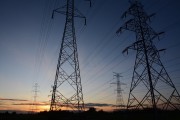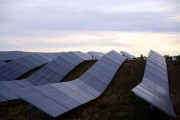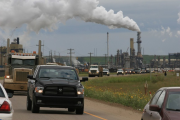On Sept 1, 2005 The Edmonton Journal published the visions of a number of prominent Albertans about what life in Alberta might look like in 2105 when the province celebrates its bicentennial.
Dr. Mary Griffiths is an environmental policy analyst with the Pembina Institute. Her unabridged submission to The Journal is below.
Dr. Mary Griffiths envisions Alberta in 2105
The Pembina Institute sees great opportunities for Alberta over the next 100 years, but there will be many challenges, too. Our ability to meet those challenges depends in large measure upon our willingness to wisely plan for the long-term. We see two potential scenarios for Alberta in 2105 and will use the oilsands as an example:
Scenario 1: "Business as Usual"
Having succumbed to the "black gold" rush of the early 21st century, Alberta's vast oilsands resources have been largely exploited to allow unabated consumption of transportation fuels in both North America and Asia. The drive to develop this resource as quickly as possible has led to the destruction of a huge swath of north eastern Alberta, where the Athabasca River is devoid of fish, and the surrounding boreal landscape is a patchwork of linear scars, and moonscapes of sand and grass that are undergoing reclamation, which has thus far proved largely unsuccessful.
The once bustling centre of Fort McMurray is largely a ghost town, with empty commercial space, homes for sale, and strangely quiet 6-lane highways. This scene is replicated in both Edmonton and Calgary, where the once prosperous economies have stagnated now that the bulk of the province's oil and gas has been depleted.
While this "Business as Usual" scenario is a reasonable projection of our current development practices, we prefer an alternate scenario:
Scenario 2: "The sustainable future"
The province has successfully managed and harnessed production of oil from the oilsands, by measured development that protects local land and water resources. A healthy and diverse boreal ecosystem retains a few, small and highly efficient oilsands production facilities that produce oil for use in high value-added production of plastics and other synthetic materials. Having developed a vision for long-term ecological, social and economic sustainability, the province of Alberta remains prosperous; public and private resources from its oil wealth have been used to diversify its economic base with a dedicated focus on a sustainable energy economy — exporting its newfound expertise around the world.
As I look around the City of Edmonton in 2105 I find that:
- All the buildings are designed to maximize passive solar energy and conserve energy. They use power that comes entirely from renewable sources — wind, solar, run-of-river hydroelectricity and geothermal. Highly-efficient homes are more comfortable, with automatically controlled levels of heating and lighting, and cleaner air. Of course, everything is designed to be reused or recycled.
- On the streets I see people walking and socializing, as most people work in their homes or local community. Increased choice of working and living environments is made possible with new information and communication technologies — allowing people to be connected over long distances — and a wide variety of building and neighbourhood designs.
- For people who do need to travel further distances for work or leisure, a comprehensive public transit network is in place to provide convenient, efficient and clean transportation. And for those people requiring more specialized trips, small, efficient fuel cell vehicles will be used, the hydrogen for them being generated with electricity from renewable sources.
- Downtown and in each sector of this compact city are convenient, high-speed mass transit centres, which are used for both goods and people for almost all long-distance travel. That travel may include a trip to one of the many protected natural areas across the province, where a wide variety of plants and animals have been allowed to flourish.
- Outside the city, which is much denser but not much larger than in 2005, are lots of greenhouses and market gardens growing local produce, though those who still have gardens like to grow their own.
Unfortunately, there are some things we can't change, even with good planning. Forest fires are very frequent due to climate change. It's sometimes possible to walk across the North Saskatchewan River, for the glaciers have melted and river flows are much reduced. Fortunately, in many parts of the province people can still access groundwater, though they may have to desalinize water from deep in the earth. The population of Alberta has grown rapidly, as a result of environmental disasters caused by climate change elsewhere in the world, but the new people join all Albertans in maintaining the sustainable economy.
How do we ensure that the second scenario is the real one? We use the royalties from our current fossil fuel industry to finance the transition to a sustainable economy. If we put the revenue from our non-renewable resources into a savings account, like the Heritage Fund, it can be used to finance the transition to renewable energy and increased energy efficiency. Communities dependent on oil and gas can be helped to adapt to economies that are sustainable in the long term. The fund will also provide the Alberta government with a long-term revenue stream for high quality heath care, education and infrastructure, as revenues from non-renewable resources decrease. Norway is doing this now; so must Alberta.
It's also time to calculate the provincial government's budget and gross domestic product in terms of the Genuine Progress Indicator — where negative impacts on human health and the environment are counted as a cost, while the addition of a new protected area or an improvement in the quality of water in our rivers count as assets. We must scrutinize all our corporate, government and individual planning decisions, to see if they meet our long-term goal of sustainability. And we should start planning for 2105 today.







